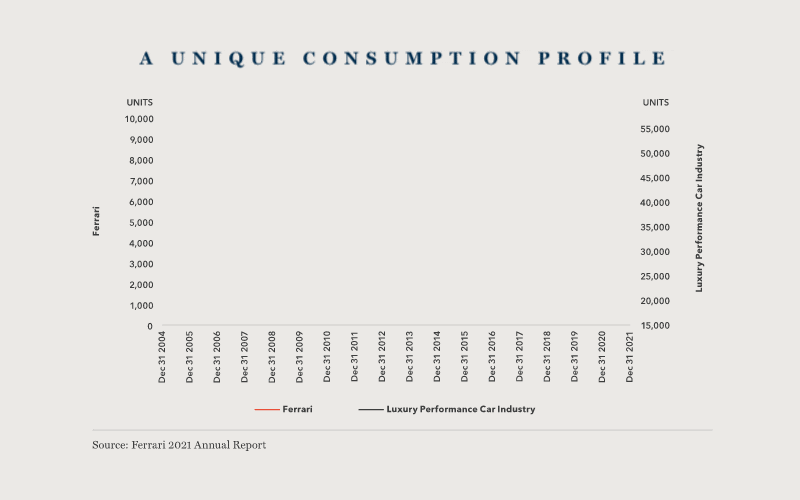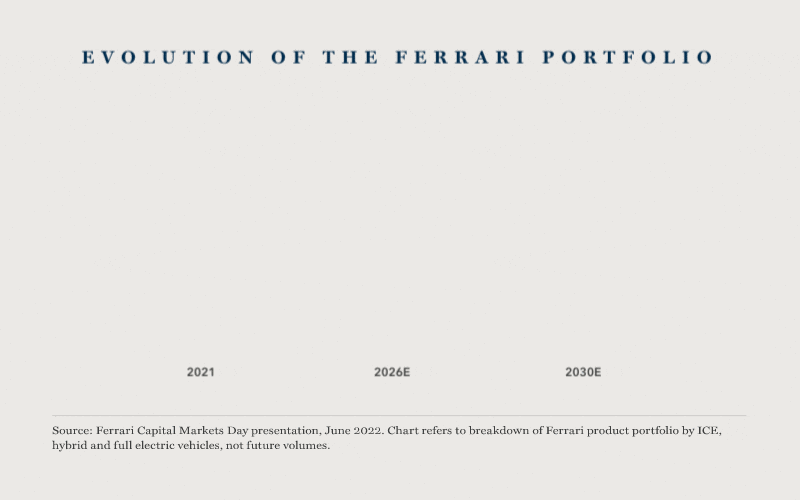We will always sell one less Ferrari than the market wants
Enzo Ferrari
Is there another brand in the world that commands such fierce loyalty from its customers as Ferrari? In 2022, roughly 13,000 cars rolled off the assembly line at the company’s fabled Maranello factory. Of these, around two-thirds were sold to existing Ferrari owners, one-third of whom already owned more than one model. Many will have been waiting two years to get their hands on the latest addition to their collection. For these ferraristi, the famous Prancing Horse logo inspires an affinity bordering on devotion. Iconic, ultra-exclusive, and steeped in history, to the enthusiast, a Ferrari is much more than simply a car.
Nor is Ferrari simply another automotive manufacturer. Its position at the apex of the luxury pyramid endows it with a profile that bears little resemblance to others in the industry, even those deemed peers at the highest end of the auto market. Resilient through economic downturns and boasting formidable pricing power, Ferrari enjoys enviable control over its destiny. And with a long-term strategy focused on leveraging these considerable strengths while adapting to the evolution of the auto industry, the company appears ideally placed to deliver excellent revenue growth and margin expansion in the years ahead.
The Lesser-Spotted Luxury Brand
It is said that Bernard Arnault, the CEO of luxury goods house LVMH, invented a paradox by “selling exclusivity by the million”. For Ferrari, less is more. A sense of scarcity is central to the Ferrari mystique. Porsche may be an aspirational brand, but the German marque churns out around 20 times more vehicles than its Italian counterpart every year. Residents of Monte Carlo or Montecito aside, most of us don’t often see a Ferrari parked outside the local store.
Protecting this reputation for exclusivity at the same time as delivering growth is the line Ferrari has always had to walk. But while the company historically managed the former well, the latter was not always a given. That changed when Ferrari went public in 2015. Since then, production growth at Maranello, while still incremental and carefully managed, has steadily increased. Pricing has also evolved. For many years, the cost of getting a foot on the Ferrari ladder remained broadly unchanged – roughly €200k for a standard model. In the last decade, that has risen to €250-300k, a rate of increase more in line with the price inflation seen in the wider luxury market.

Where Ferrari has truly initiated a step change, however, is in product development. In 2018, the company announced it would release a total of 15 new models over a five-year timeframe, a level of expansion without historic precedent. Aiming to capitalise on the extraordinary loyalty of the Ferrari customer base, it has proved a hugely successful strategy, with the traditional sports and GT models increasingly supplemented with higher value, volume- and time-limited specials and Icona series.
Residents of Monte Carlo or Montecito aside, most of us don’t often see a Ferrari parked outside the local store
The latter in particular stands for everything that makes the brand so desirable to the enthusiast. A perfect marriage of heritage, innovation, and ultra-exclusivity, the Icona combines the “timeless design of iconic Ferraris” with engineering excellence, state-of-the-art technology, and a price tag running into the millions. The first model to roll out of Maranello was the Monza in 2018. All 499 had been sold in advance. Three years later, the Daytona was launched with a production run of 599. All 499 Monza owners bought a Daytona. The remaining 100 were offered to and purchased by a select group of Ferrari collectors.
The other major addition to the portfolio is the Purosangue, Ferrari’s first four-door four-seater car. Meaning ‘thoroughbred’ in Italian, the Purosangue has been labelled an SUV by some industry observers, a tag from which Ferrari has been quick to distance itself. It is, according to CEO Benedetto Vigna “a sports car opening a new segment.” However you choose to define it, the Purosangue has been an immediate success. Unveiled in September 2022, it is now sold out for the next two years.
Can a fully electric vehicle ever truly deliver the thrills of the traditional Ferrari driving experience?
The other major focus of product development is the gradual decarbonisation of the Ferrari fleet. While Ferrari has progressively reduced its emissions in recent years through a variety of innovations, often leveraging the cutting-edge work of its Formula 1 racing team, the biggest step to date was the launch in 2019 of a first plug-in hybrid electric vehicle. A full battery electric vehicle is expected in 2025. Having successfully replicated the Ferrari driving experience with its hybrid model, management is confident of repeating the trick. Nothing is being left to chance. Work is even underway to create a sound signature that, while different to the throaty roar of Ferrari’s legendary internal combustion engine, will nonetheless “stir up feelings and emotions”. Retaining “the soul of the machine” is paramount.

Can a fully electric vehicle ever truly deliver the thrills of the traditional Ferrari driving experience? Perhaps that’s asking the wrong question. Given the loyalty of its customer base, Ferrari just needs to deliver an exceptional electric vehicle with the Prancing Horse on the hood. The company was originally reluctant to commit to full electrification until it was confident that it had the technology to create something genuinely new for the market. With chairman John Elkann stating that electrification will now allow Ferrari to make “even more unique cars”, that day appears to have arrived. One can almost hear the ferraristi opening their cheque books in anticipation.
Important Information
This article is provided for general information only and should not be construed as investment advice or a recommendation. This information does not represent and must not be construed as an offer or a solicitation of an offer to buy or sell securities, commodities and/or any other financial instruments or products. This document may not be used for the purpose of an offer or solicitation in any jurisdiction or in any circumstances in which such an offer or solicitation is unlawful or not authorised.
Stock Examples
The information provided in this article relating to stock examples should not be considered a recommendation to buy or sell any particular security. Any examples discussed are given in the context of the theme being explored.


